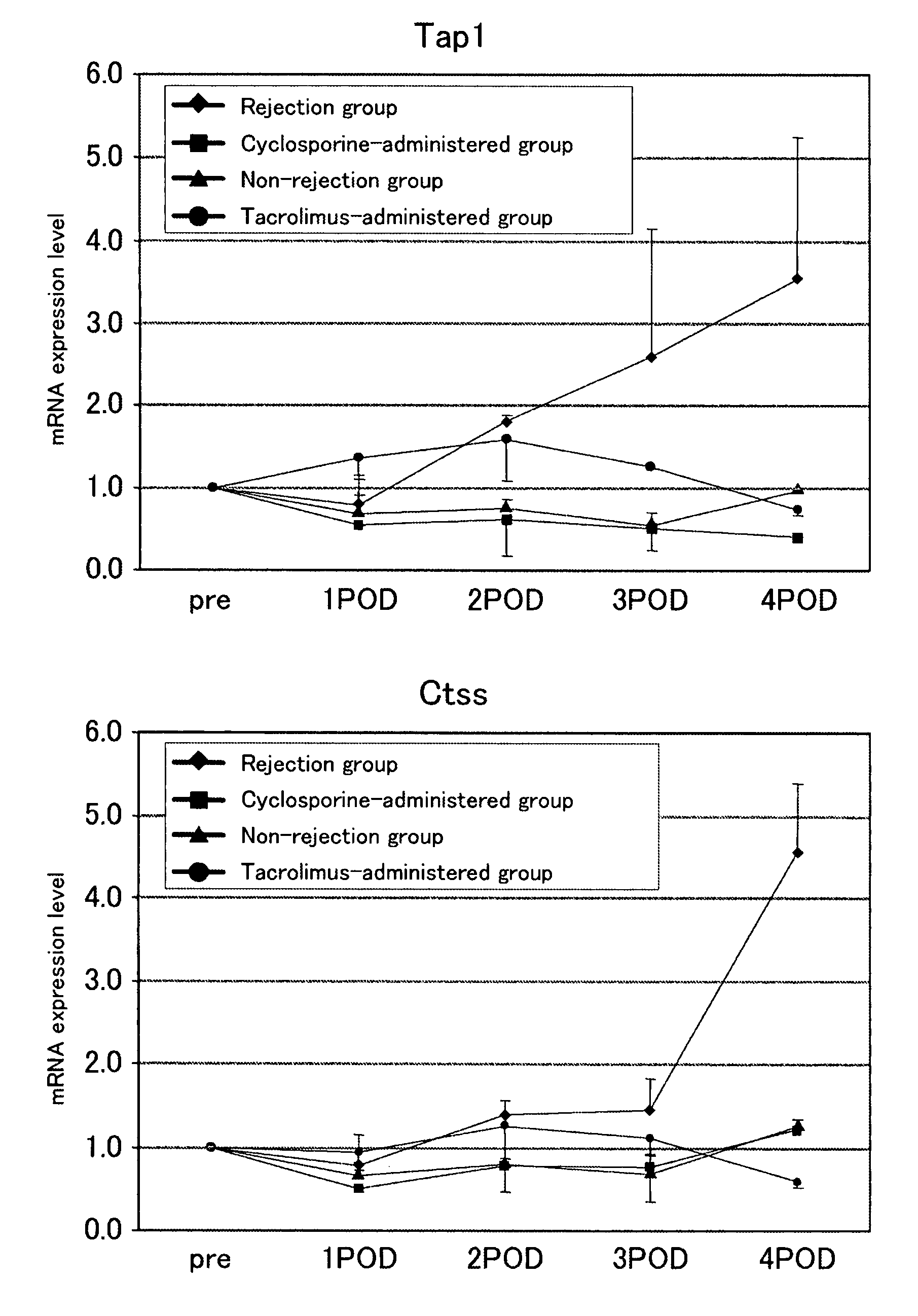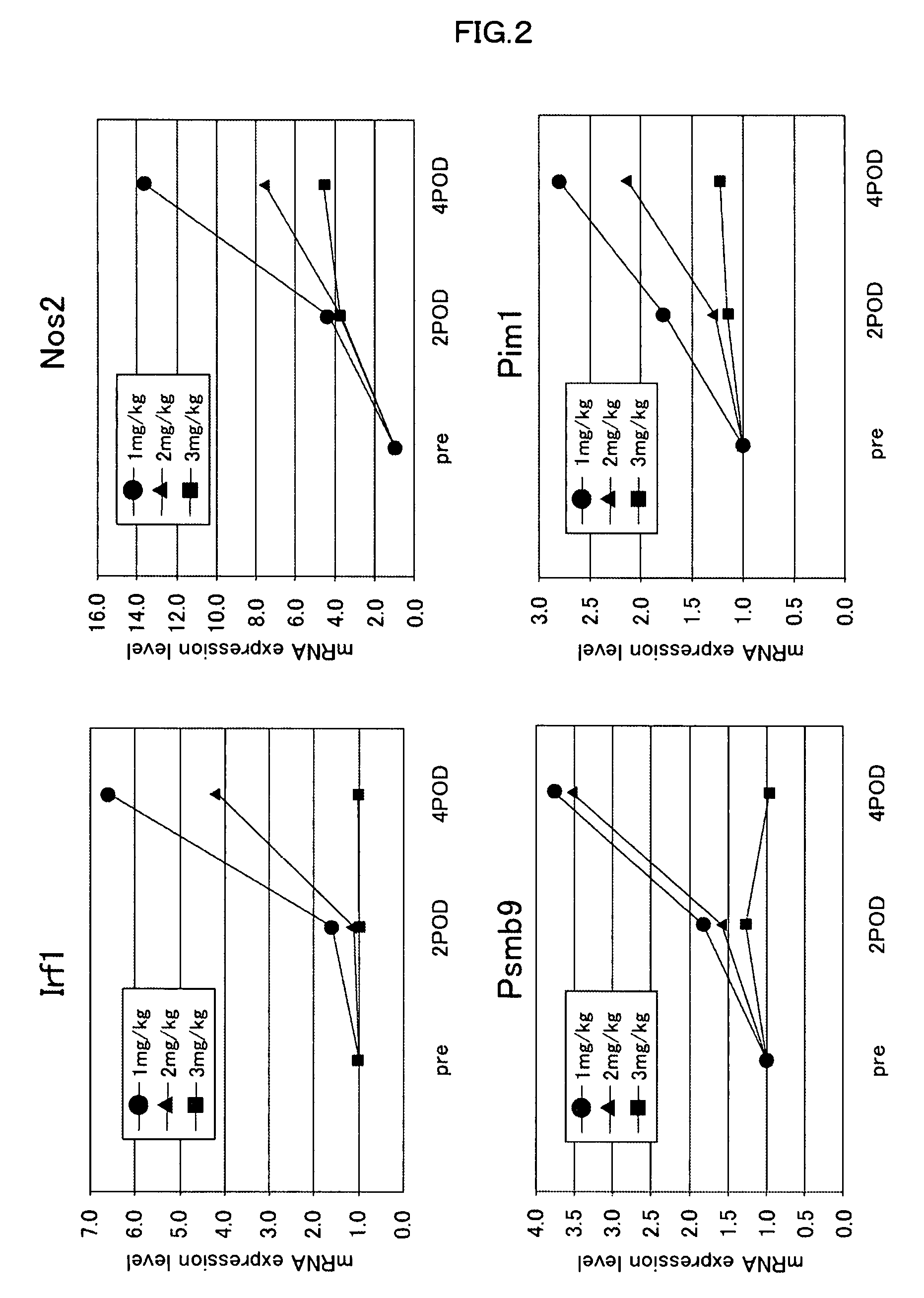Gene Marker and Use Thereof
a technology applied in the field of gene markers and diagnostic methods for rejection, can solve the problems of failure to repeat treatment, inability to perform easily, and inability to achieve repeated treatment, etc., and achieve the effect of quick, simple and convenien
- Summary
- Abstract
- Description
- Claims
- Application Information
AI Technical Summary
Benefits of technology
Problems solved by technology
Method used
Image
Examples
example 1
[0074]By using Lewis rats as donors and isogenic (Lewis) rats as recipients, heart transplantation was performed (non-rejection group; n=3). In addition, by using ACI rats as donors and allogeneic (Lewis) rats as recipients, heart transplantation was performed. Three (immunosuppressive agent-administered group; n=3) out of the six allogeneic recipients received a subcutaneous injection of 5 mg / kg BW of cyclosporine (manufactured by Novartis Pharmaceuticals Corporation; dissolved in saline) on the day of transplantation (day 0), followed by daily subcutaneous injections of cyclosporine at the same dose. The remaining three rats did not receive any immunosuppressive agent (rejection group; n=3). The Lewis and ACI rats used were 8 to 10-week-old males and weighed between 200 and 300 g.
[0075]On post-transplantation day 4 (in the rejection group, the cessation of the heartbeat of the transplanted heart had not been confirmed yet), laparotomy was performed on three rats in each of the non...
example 2
[0078]To examine whether the genes identified in Example 1 can serves as indicators of rejection or the efficacy of an immunosuppressive agent, 200 μl of blood was drawn from the caudal vein of individual mouse in the non-rejection group, rejection group, and immunosuppressive agent-administered group (the cyclosporine-administered group received a subcutaneous injection of 5 mg / kg BW of cyclosporine on the day of transplantation, followed by daily subcutaneous injections; the tacrolimus-administered group received a subcutaneous injection of 1.28 mg / kg BW of cyclosporine on the day of transplantation, followed by daily subcutaneous injections), starting from the day before transplantation and daily until post-transplantation day 3. On post-transplantation day 4, laparotomy was performed on individual rats, 200 μl of blood was drawn from the inferior vena cava, and expression levels of gene markers (Irf1 (n=5), Psmb9 (n=5), Nos2 (n=3) or Pim1 (n=3); for the tacrolimus-administered g...
example 3
[0080]Next, to ascertain whether the expression levels of the gene markers change depending on the dose of an immunosuppressive agent, on the day before transplantation, on post-transplantation day 2, and on post-transplantation day 4, 200 μl of blood was drawn from the caudal vein of rats which had received a subcutaneous injection of 1 mg, 2 mg, or 3 mg / kg BW of cyclosporine on the day of transplantation, followed by daily subcutaneous injections. Then expression levels of gene markers (Irf1, Psmb9, Nos2, or Pim1) were measured. The expression levels of the gene markers were measured by quantifying their mRNAs, which had been extracted from blood in the same manner as described in Example 1.
[0081]As shown in FIG. 2, it was confirmed that for each gene marker the expression level was decreased with increasing dose of cyclosporine. This indicates that the dose of cyclosporine correlates with the expression level of the gene marker (Irf1, Psmb9, Nos2, or Pim1). This correlation does ...
PUM
| Property | Measurement | Unit |
|---|---|---|
| concentration | aaaaa | aaaaa |
| concentration | aaaaa | aaaaa |
| concentration | aaaaa | aaaaa |
Abstract
Description
Claims
Application Information
 Login to View More
Login to View More - R&D
- Intellectual Property
- Life Sciences
- Materials
- Tech Scout
- Unparalleled Data Quality
- Higher Quality Content
- 60% Fewer Hallucinations
Browse by: Latest US Patents, China's latest patents, Technical Efficacy Thesaurus, Application Domain, Technology Topic, Popular Technical Reports.
© 2025 PatSnap. All rights reserved.Legal|Privacy policy|Modern Slavery Act Transparency Statement|Sitemap|About US| Contact US: help@patsnap.com



